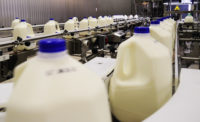All dairy operations do some quality testing. Some might just do the very basics — e.g., butterfat testing and antibiotic testing — while others have large laboratories with the capability of conducting a multitude of tests.
Consumers also run quality tests on products. While few consumers test the pH of our products, and I have never seen a Babcock bottle in my neighbor’s kitchen, all consumers run sensory tests on our products. Every consumer evaluates the color, flavor, odor and mouthfeel of our products every time he or she consumes them. So why would we not do the same?
Sensory evaluation is critical
Over the years, I have seen chocolate milk with no sugar, vanilla ice cream with no vanilla, “malty” milk and cottage cheese with no salt. All of these defects could have been identified if someone had just tasted the product. A robust sensory evaluation of our products, from ingredients to finished products, is a “must do.”
Sensory evaluation is defined by The Institute of Food Technologists as “A scientific discipline used to evoke, measure, analyze and interpret reactions to the characteristics of food and materials as they are perceived by the senses of sight, smell, taste, touch and hearing.” Properly conducted, it is a valid and reliable quality test.
While frequently used to evaluate finished products at the time of production, sensory evaluations to analyze shelf life and the quality of ingredients should not be overlooked. Products should be examined at the end of their predicted shelf life to evaluate quality. (Remember: That is the test the consumer is conducting.) It is recommended that all fluid and cultured products be held to at least the end of code at 45 degrees Fahrenheit and then fully examined for taste, odor and appearance.
In addition, ingredients such as raw milk, cream, milk powders, whey powders, fruits, nuts, sweeteners, flavorings and yes, even water should be examined prior to use. All of these have been known to cause sensory defects in finished products. Once an off-flavor or odor finds its way into product, it cannot be masked or removed.
Common defects found in raw milk include feed, foreign, rancid, astringent/chemical, cowy/barny, high acid/sour, malty, unclean, fruity and onion. Finished product defects include all the defects noted in raw milk, as well as cooked, flat, oxidized and stale.
Cultured products may also have manufacturing defects such as high acid, green, yeasty, moldy, high salt, bitter and the lack of flavor or aroma. Common defects in frozen desserts, meanwhile, might be lack of freshness, old ingredient, syrupy, lack of flavor or color, lack of inclusion, whey flavor, unnatural flavor, course texture, weak body, crumbly or gummy, chewy or sandy texture.
None of these defects requires a sophisticated laboratory to be noticed by consumers. And while they might not know exactly what they dislike, they will judge the product as being poor in quality and not meeting their expectations.
An effective sensory evaluation protocol
How then does a facility establish an effective sensory evaluation protocol? There are several steps.
- Provide an environment suitable for sensory evaluation.
- No off-odors in the room.
- Adequate lighting.
- A table or countertop for the samples.
- A means to expectorate product after tasting.
- Use trained evaluators.
- More than one individual is better; a panel is best.
- Avoid comments that may influence others.
- Train the individuals in evaluation of defects.
- Nonsmokers make better evaluators.
- Refrain from tasting immediately after spicy or highly flavorful meals.
- Maintain a schedule.
- Set up times for evaluation.
- Evaluate all finished product prior to release.
- Evaluate all ingredients prior to use.
- Evaluate work-in-progress as required.
- Evaluate product at the end of code or beyond.
- Provide the needed tools.
- Spoons, bowls, plates and cups as needed.
- Provide “palate cleansers” as needed (water or crackers).
- Use forms or another method to record results.
- Use blind samples if appropriate.
- A “gold standard”/no-defect sample may be helpful.
How do your products score in the ultimate consumer test? High marks bring consumers craving for more. Poor scores will simply just leave a bad taste in their mouth. In this case, it really is all about taste.



